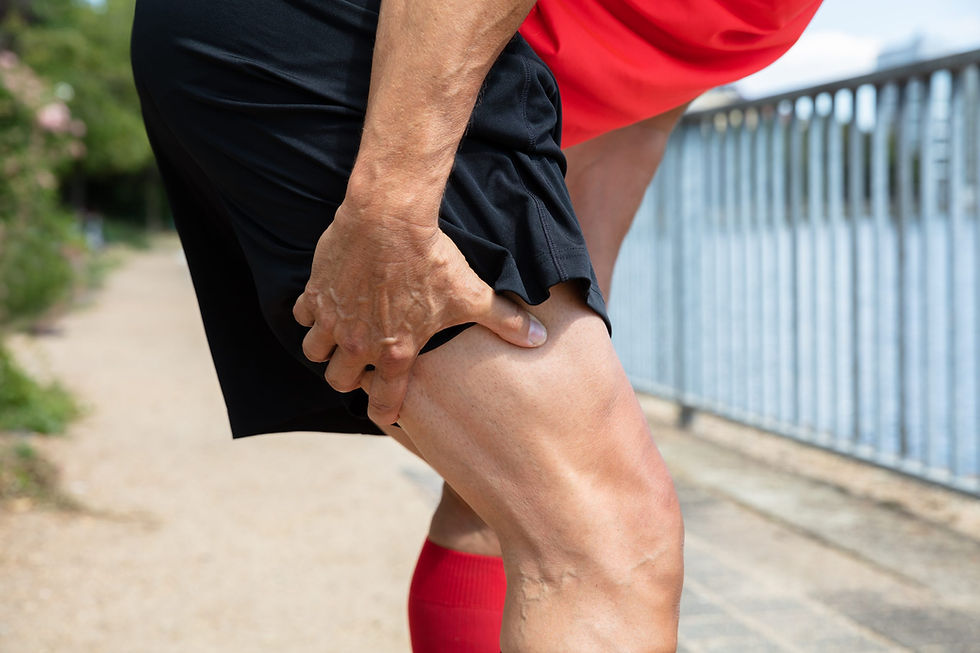Hamstring Tendinopathy Vs Hamstring Strain. What's the Difference?
- pat0648
- May 4, 2022
- 2 min read
Updated: Jul 26, 2024
Ever wondered what the difference between a hamstring strain and hamstring tendinopathy is? Whether you have one or the other, as well as what the rehabilitation should look like for each?
Learn the difference today; including the signs, symptoms and cause of injury between the two!
But firstly, what is a strain and what is a tendinopathy?
Hamstring strains are generally defined by the damaging of the hamstring muscles fibres. This can be caused by an excessive load of stretch injury to the hamstring muscle.
Hamstring tendinopathy is generally caused by a failed healing response to the tendon, arising from overuse and poor load management.

Check out our table below!
Injury | Cause/Mechanism of Injury | Signs & Symptoms | Classification | Rehab Insight |
Hamstring Strain | When a high amount of stress is placed through the hamstrings, either by excessive loading or stretching, which causes damage/injury to the muscle fibres | - Potentially affected gait - Pain & bruising at the site of injury, pain with palpation - Pain felt at the time of injury - Weakness of the hamstring muscle - Pain with contraction of the hamstring muscle | Grade I: Few fibres damaged Grade II: Approx ½ the fibres have been damage/torn Grade III: More than ½ the fibres are ruptured//torn | Early: Promote healing of the muscle eg: isometrics/eccentrics & manual therapy Mid: Continued healing of the muscle, introducing concentric strengthening Late: Advanced strengthening, introducing power, acceleration and deceleration |
Hamstring Tendinopathy | Hamstring overuse and poor load management, causing a failed healing response of the tendon, resulting in inflammation and degeneration. | - Aching in buttocks (proximal hamstring tendon) - Aching back of knee (distal hamstring tendon) - Leg stiffness - Soreness in the hamstrings after prolonged sitting - Delayed soreness to buttocks/back of knee after excessive use/activity. | Proximal (high): Degeneration and inflammation of the hamstring tendons which attach to the back of the pelvis
Distal (low): Degeneration and inflammation of the hamstring tendons which attach to the back of the knee | Early: Promote healing of the tendon, e.g: isometric strengthening & shockwave therapy Mid: Continued tendon healing, introduction of eccentric loading Late: Advanced loading, introduction of tendon elasticity training e.g: hopping & jumping |
Why people fail recovery & their return to sport
Hamstring strain:
Poor early stage loading of the muscle, where exercise prescription is either too advanced and not allowing the tissue to heal, or too easy and not stimulating the muscle adequately enough to promote healing.
Poor mid-stage strengthening before transitioning to advanced loading, involving power, acceleration/deceleration.
Poor late stage rehabilitation before returning to sport/activities (no advanced strengthening, sprint drills or power training).
Hamstring tendinopathy:
Poor isometric loading e.g., the angle the tendon is placed in, as well as the parameters/duration set for early stage healing which is vital. Failure to ineffectively achieve these factors can lead to reduced tendon capacity in later stages.
Poor transition from mid to late stage where the tendon has not yet healed sufficiently before beginning tendon elasticity training (hops & jumps).
Poor late stage rehabilitation, where there has been in-effective transitioning from advanced exercises to returning to sport/activities. For example, no re-introduction of controlled sprint and change of direction drills.
Poor load management upon returning to sport/activities (doing too much too soon).
Who is best to see for these conditions?
The best practitioner for your recovery typically depends on the stage of recovery and degree of pain experienced. However, a multidisciplinary approach where both Sydney physiotherapists and exercise physiologists work together can give the best outcomes for a complete recovery for both injuries.
Early stage:
A physiotherapist can help reduce pain and effectively begin the healing process through manual therapy and exercise prescription.
Mid stage:
A physiotherapist will typically continue with manual therapy and exercise prescription to promote the healing process. An exercise physiologist (EP) will begin transitioning of localised to functional strengthening, in preparation for end stage rehab & return to activities.
End stage:
An EP will closely guide you to return to your sport/activity by:
Ensuring the injury and surrounding structures are conditioned to deal with the demands of sport.
Ensuring body mechanics are restored after a period of rest from sport.
Re-introducing running based drills and advising on guidelines for progressive return to sport.
This is essential to reduce the risk of re-injury.
Just suffered a hamstring injury yourself?
Click the below below to come see us in person, we'd love to help! We are based in Sydney with 4 convenient locations - Sydney CBD, North Sydney, Chatswood & Mosman.
Alternatively, if you're not based in Sydney we have an Online Coaching platform available, readily accessible for anyone, anywhere in the world! There you can have access to our renowned Physiotherapists & Exercise Physiologists. Click the button below.
Hope you enjoyed the read!
Infinite Health Team




























Comments